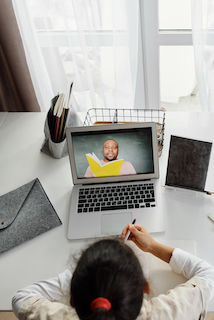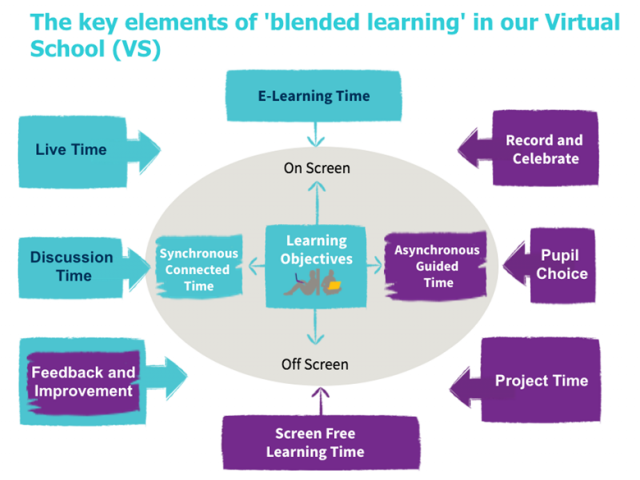Many schools across the globe moved towards distance learning approaches as the global pandemic hit. While international schools prepare for the start of the next academic year, the question as to whether distance learning is just a temporary solution or is here to stay is in the air. Some schools have already formed a solid plan towards hybrid methods of schooling, combining online instruction with face-to-face. Drawing on our community of international schools, we’d say that innovative approaches to teaching and learning are well underway…
Online education is here to stay.
Harvard recently announced that only 40% of their undergraduates will attend campus and all of their classes will be available online. If one of the most renowned education establishments is transitioning, what’s stopping international schools from following suit? Blended approaches to lesson delivery challenge more traditional methods. Some international schools have been working on innovative teaching and learning strategies and have adopted a blended approach into their curriculum.
What is blended learning?

Simply put, blended learning is a mix of face-to-face and online teaching and learning methods. In this respect, it’s nothing new as schools have been using digital learning in schools and for homework for years. However, now there are more ways to apply blended learning, and certainly, since the global pandemic, the approaches, impacts, and the future of blended learning styles are being considered more holistically.
Types of blended learning in International schools.
Within a brick and mortar environment, blended learning has been utilised for some time through technology-rich activities. Some models were developed and have been adopted by teachers and written into the curriculum. Models such as the flipped classroom, station-rotation etc. can all be considered blended learning methods.
The Flipped Classroom.
Perhaps the most common blended learning approach is the Flipped Classroom. The premise is that students watch pre-recorded lectures or videos at home and then come to school to do ‘the homework’. This is flipped in the sense that instead of learning the bulk of content in a group setting they do so at home digitally and then reflect and discuss their learning in the face-to-face school setting. The most well-known example of a flipped learning resource might be The Khan Academy, which holds up to more than 235 million lessons available online.
Blended learning solutions in the time of Covid-19
Blended learning has developed beyond earlier models as Covid-19 has closed schools around the globe. Ways to use these approaches outside of the school itself within a holistic approach has grown exponentially. Welcome, the virtual school.
What are virtual schools?
A blended learning approach in a virtual school is where students get a mixture of live screen time with their teachers and peers as well as access to pre-recorded and curated learning experiences that they can access at their own time. According to Naima Charlier– director of teaching and learning at Nord Anglia International School in Hong Kong, using different learning elements blended makes a successful virtual school. “a blended approach ensures that the maximum learning is achieved through the delivery of a holistic education…this means the whole child is nurtured and education goes beyond the traditional model.” The learning experience of virtual schools, therefore, moves beyond subject drilling and assessment and offers offline learning through holistic approaches such as reading activities and movement & play outside the virtual classroom.
Synchronous & asynchronous instruction
Synchronous and asynchronous refers to live instructional and non-instructional methods of teaching and learning. Since schools closed during the global pandemic, synchronous teaching rose in the digital realm. Teachers got on Zoom and Google Hangouts. Navigating time zone differences and the rise of “zoom fatigue” made this a short-lived celebration. Some teachers opted for an asynchronous format as well, allowing students to delve further into concepts and then come together for live discussions. This is much like the flipped classroom only fully virtual.
International schools that use the blended learning approach
International schools that have taken on a virtual school or blended learning approach all have something in common. They have all applied an innovative approach to their education strategy that they plan to use beyond the current pandemic situation.
Nord Anglia School Group created a “Virtual School Experience” that is used across their numerous international schools. The virtual school experience enables students to access their usual lessons online and connect with their teachers and peers. They devised a plan for their virtual school that takes on a holistic approach to education, based on global citizenship, collaboration and practical aspects outside the classroom. While this proved useful in the time of Covid-19 it will continue to be a part of the school structure. The feedback has been positive: a parent of a student at Northbridge International School Phnom Penh stated: “With support from my child’s amazing teacher, it has been great being able to give him one-on-one encouragement for learning. The morning Google Hangout to get the day started is brilliant.”
LiPo Chun UWC of Hong Kong is one of 18 UWC schools and colleges across the globe. LiPo Chun has been delivering distance and blended learning approaches and has been considering the future of education amidst the complexities that Covid-19 brought about. LPCUWC takes innovation and sustainability seriously and Principle Arnett has been running webinars and forums focused on approaches for this titled Futures of Education 4.0 industry & beyond. They have plans to continue their distance education into the future.
Brookes Moscow is also looking to innovative ways to keep digital learning at the forefront in these pivotal times. They created a strategy and handbook on digital learning for their team and have deployed a distance learning system to support their IB students. They have adopted specific software to support their distant learning packages and surveyed levels of satisfaction which demonstrated the followed: “more than 70% of Year 7-11 students (IB MYP 1-5) rated the quality of the distance learning provided as ‘very good and excellent’, and the level of attendance at lessons with distance learning turned out to be higher than full-time attendance and exceeded 91%.”
Innovation in teaching & learning in virtual or hybrid schools.
In a school building, students and teachers gain moments away from their studies as they take breaks, walk from class to class, change their environment, or move to different subjects. This is an entirely different situation online and is to be considered when designing virtual schools or hybrid approaches to learning. The Nord Anglia school group’s Virtual school is a great example of utilising both synchronous and asynchronous time with students. This means both connected time with a teacher and student where discussions, assessments, feedback can take place, and then the asynchronous time where screen-free, student choice and their projects are included in the timetable.

These innovative and fully adapted approaches are crucial as we navigate the changing times. While there are pros and cons within the model, only time will tell how they are received and adapted accordingly. What seems to be clear is that international schools are adapting their strategies and planning for hybrid models to be here for the foreseeable…
Have you any experience working with hybrid or blended learning approaches? We want to hear from you! Reach out at editor@teacherhorizons.com with your stories.
Sign up to teacherhorizons today to join the most innovative and progressive international schools around the world!



